
First Romanian School
Encyclopedia

St. Nicholas Church, Brasov
Saint Nicholas Church is a Romanian Orthodox church in Braşov, dominating the historic district of Şchei.The church was established in 1292. It was mentioned in a Papal bull issued in 1399 by Pope Boniface IX. Starting in 1495, the church was rebuilt in stone by the locals, with help from Vlad...
, itself located in the historic district of Şchei, now part of the city of Braşov
Brasov
Brașov is a city in Romania and the capital of Brașov County.According to the last Romanian census, from 2002, there were 284,596 people living within the city of Brașov, making it the 8th most populated city in Romania....
.
It is also home to the first Romanian Bible
Bible
The Bible refers to any one of the collections of the primary religious texts of Judaism and Christianity. There is no common version of the Bible, as the individual books , their contents and their order vary among denominations...
, and what can be loosely described as the first school magazine. The next door museum houses a variety of first Romanian books and the first printing press.
Vasile Oltean is both the caretaker and the guide, and has spent the last 40 years of his life working at the First Romanian School - as a priest for the last six years, and a teacher and pupil before that.
The church was built in the 14th century. The building of the First Romanian school had been erected in 1495. The school had been re-built in 1597.
In the opinion of Vasile Olteanu, the school had started to function long before 15th century, like in many other situations.
The background of the students was varied and, being the only school in Transylvania
Transylvania
Transylvania is a historical region in the central part of Romania. Bounded on the east and south by the Carpathian mountain range, historical Transylvania extended in the west to the Apuseni Mountains; however, the term sometimes encompasses not only Transylvania proper, but also the historical...
, people came from far and wide, although mainly from the southeast of the region. Not everyone went to school, however. Each village paid for one student to attend the school, in order to learn to teach upon returning and share their education. Over time, a total of 1730 students attended the school; however the most at one time was 110. It is not known exactly how the school was founded, but it was recognised by the Pope
Pope
The Pope is the Bishop of Rome, a position that makes him the leader of the worldwide Catholic Church . In the Catholic Church, the Pope is regarded as the successor of Saint Peter, the Apostle...
in 1395.
The school remained in use right up until the 20th century, and closed in 1941. The collections of archaic and original items were gathered starting in 1933 and were first organized in a museum in 1964.
The museum also contains the first Romanian printing press
Printing press
A printing press is a device for applying pressure to an inked surface resting upon a print medium , thereby transferring the ink...
. Only 39 books were made by this press, which is hardly surprising given the labour required, however the work it did produce included plenty more firsts. The first Romanian letter in Latin was produced by the press, the first Romanian schoolbook and the first Bible, which was printed on goatskin and had a cover weighing a hefty seven kilograms.

There is a plaque above the school entrance. In English, the text reads: "This ancient place of learning, the first Romanian school in all of Greater Romania
Greater Romania
The Greater Romania generally refers to the territory of Romania in the years between the First World War and the Second World War, the largest geographical extent of Romania up to that time and its largest peacetime extent ever ; more precisely, it refers to the territory of the Kingdom of...
, was completely rebuilt in stone in the years 1595-1597 through the generous gift of Prince Aron
Aron Tiranul
Aaron the Tyrant , sometimes credited as Aron Emanoil or Emanuel Aaron , was twice Moldavian Voivode : between September 1591 and June 1592, and October 24, 1592 to May 3, 1595. He was Alexandru Lăpuşneanu's son....
of Moldavia
Moldavia
Moldavia is a geographic and historical region and former principality in Eastern Europe, corresponding to the territory between the Eastern Carpathians and the Dniester river...
and through the care for learning of the Archpriest Mihai, being built anew in the year 1761. Flowering under the shield of the Church
Romanian Orthodox Church
The Romanian Orthodox Church is an autocephalous Eastern Orthodox church. It is in full communion with other Eastern Orthodox churches, and is ranked seventh in order of precedence. The Primate of the church has the title of Patriarch...
, it served for hundreds of years as a centre of education for youth and adults. And after the most important primary schools and the Orthodox high school of Braşov were built, [it functioned] as a meeting place for the parish council and later sheltered the historic archives of St. Nicholas Church. Year 1946."

